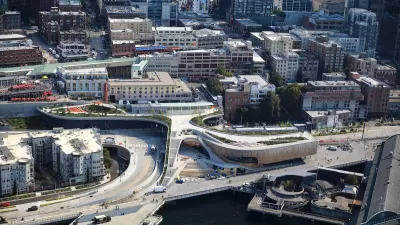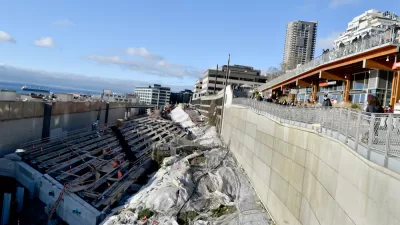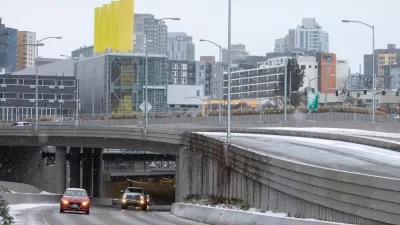With elections coming up, local politicians are peddling various plans for the replacement of the Alaska Way Viaduct -- though there is increasing consensus around removing the freeway and creating a waterfront boulevard.
"The debate about Seattle's Alaskan Way Viaduct used to be a very public, contact sport, but as many local politicians were carted off the field, the controversy moved to a 30-person stakeholders group, who meet very quietly. Meanwhile, the politicians edge back onto the playing field and hint at solutions.
Gov. Chris Gregoire addressed a group of civic worthies Wednesday and dropped broad hints that she is now a fan of the no-tunnel, no-viaduct, surface-plus-transit solution that she used to excoriate. Noting that Seattle is an "international city," Gregoire defined that gauzy term by saying an international city could not possibly have on-street parking downtown or two-way streets. (So much for New York and Paris, but nevermind.) Those may be weird definitions, but they are unmistakable signals that she is buying into the stakeholder group's emerging consensus to divert a lot of viaduct through traffic to Seattle's downtown streets, thus needing only a four-lane, slow boulevard on the central waterfront."
"The story marks a remarkable political journey by local politicians. They have gone from thinking that all the present traffic needed to be accommodated by any solution to the viaduct to thinking in terms of moving people (in various modes), not just cars. All these urban freeways were once paid for largely by federal money. Now they are in need of expensive repair and the feds have fled. One solution is to scrape up local money to rebuild them. When the voters said a loud No to that idea (and the climate change issue moved to the fore), we quietly thought about another approach: removing freeways. It might work."
FULL STORY: Psst! Wanna see the Viaduct disappear?

Planetizen Federal Action Tracker
A weekly monitor of how Trump’s orders and actions are impacting planners and planning in America.

Restaurant Patios Were a Pandemic Win — Why Were They so Hard to Keep?
Social distancing requirements and changes in travel patterns prompted cities to pilot new uses for street and sidewalk space. Then it got complicated.

Maui's Vacation Rental Debate Turns Ugly
Verbal attacks, misinformation campaigns and fistfights plague a high-stakes debate to convert thousands of vacation rentals into long-term housing.

Boulder Eliminates Parking Minimums Citywide
Officials estimate the cost of building a single underground parking space at up to $100,000.

Orange County, Florida Adopts Largest US “Sprawl Repair” Code
The ‘Orange Code’ seeks to rectify decades of sprawl-inducing, car-oriented development.

Maui's Vacation Rental Debate Turns Ugly
Verbal attacks, misinformation campaigns and fistfights plague a high-stakes debate to convert thousands of vacation rentals into long-term housing.
Urban Design for Planners 1: Software Tools
This six-course series explores essential urban design concepts using open source software and equips planners with the tools they need to participate fully in the urban design process.
Planning for Universal Design
Learn the tools for implementing Universal Design in planning regulations.
Heyer Gruel & Associates PA
JM Goldson LLC
Custer County Colorado
City of Camden Redevelopment Agency
City of Astoria
Transportation Research & Education Center (TREC) at Portland State University
Camden Redevelopment Agency
City of Claremont
Municipality of Princeton (NJ)





























